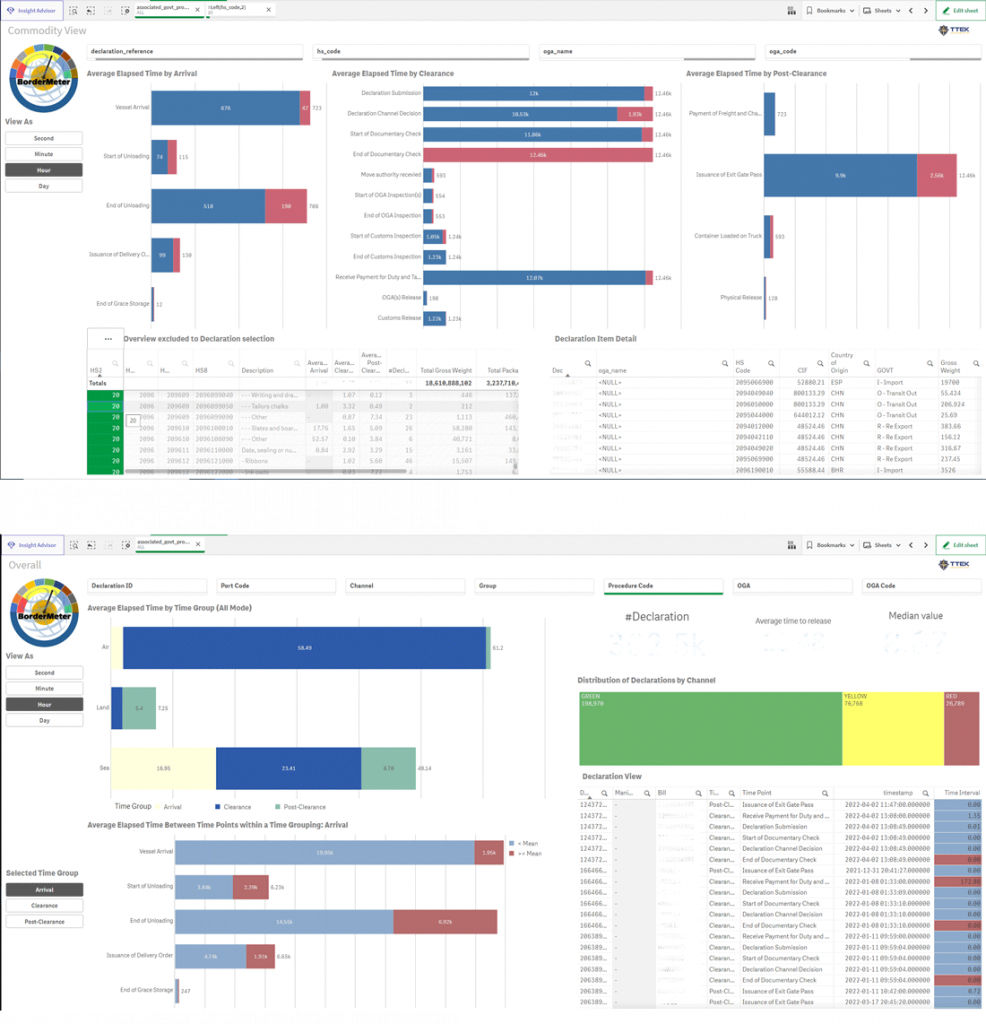Abu Dhabi launches application for real-time measurement of the time required to release goods
3 March 2023
By Mike Squirrell and Dan Rochon with Chris Thibedeau of TTEK Inc. and Dr. Ali Makki and JP Simpson of Abu Dhabi Department of Economic Development and Eng. Khalid Hasan Ali Al Marzooqi and Brahim Tchina of Abu Dhabi Customs Administration and Dr. Noura Al Dhaheri of Maqta/AD Ports GroupUsing data analytics, the Emirate of Abu Dhabi has developed an application automating the measurement of release and clearance times at the border. The result is an ability to measure time release dynamically and in real time, and to overcome the limitations of the traditional Time Release Study approach.
Abu Dhabi (the largest emirate in the United Arab Emirates) continues to promote and embrace international best practices to modernize border and trade processes. Many local and federal partners are involved, including Abu Dhabi Department of Economic Development (ADDED), Abu Dhabi Customs Administration (ADCA), AD Ports Group, and Etihad Airport Services Cargo. The collective effort aims to facilitate trade, increase security and controls, and enhance revenue collection and good governance, and falls within the framework of Customs, Trade, and Other Government Agency (OGA) programmes.
Reform and measure
In 2020, they set the ambition for Customs procedures to be so seamless and effective as to become invisible. Driven by a strategy of leveraging technology, ADCA has streamlined and fully digitized its services and procedures. It has developed an automated inspection system, supported by the adoption of a competency-based approach to human resource management and a new comprehensive competency framework[1]. In a record time of two years, Abu Dhabi has also developed its Advanced Trade Logistics Platform (ATLP), an ambitious Single Window environment.
To measure the effects of tools and reforms, ADCA had been conducting Time Release Studies (TRS), the tool developed by the WCO to measure the actual time taken for the release and/or clearance of goods – from the time of arrival until the physical release of cargo – as well as the effectiveness and efficiency of border procedures relating to imports, exports and transit movements of goods.
As part of the ATLP project and under the leadership of ADDED, an Automated Time Release Application is being implemented to provide all partners with real-time visibility into time release measurements at the border. This is being achieved using the principles of Advance Commercial Information (ACI), by getting the right information at the right time. To better understand why Abu Dhabi has chosen this path, it may be important to discuss the limitations of the traditional legacy Time Release Study (TRS) approach.
Limitations of traditional TRS
Legacy Time Release Studies are static (one time) and based on manual data collection, observation, and qualitative analysis. This lack of automation makes it difficult to repeat this activity, and generally requires the same time and level of effort to accomplish similar results. Legacy studies are slow and ineffective, with the following issues often emerging:
- The Hawthorne effect: this is when individuals modify an aspect of their behaviour in response to their awareness of being observed. Often, when a team of monitors arrives at a checkpoint and commences the process of recording events, the process magically improves.
- Sample selection bias: in a traditional Time Release Study, “outlier” transactions are often excluded from the data set. The outlier transactions provide valuable insight into sometimes systemic issues, and should not be discarded. The lifecycle is also incomplete during the period of time the monitors were at the checkpoint. In addition, it is important that a wide range of commodities should be covered within a TRS. The ability to determine which commodities are cleared rapidly and which are slower to clear is important and can highlight issues with risk management or intra-agency co-ordination related to specific commodities that might otherwise go unnoticed.
- The risk management framework is not fully considered: it can be assumed that goods imported by an Authorized Economic Operator should be cleared in a shorter time than is the case for a first-time importer. In addition, goods marked for physical examination or scan should take longer to clear than those passed through the green channel. Validating this hypothesis is important, as we have discovered that in many countries this logic does not translate on the ground.
- Delays by other Government agencies: it is common for the assessment to be held up due to inspection processes mandated by other Government agencies. Co-ordinated inspections are sometimes overruled by Customs, or conducted at an importer’s premises, and thus fall outside a standard TRS.
- Simplistic use of averages: taking a median average when calculating aggregate clearance times skews the results as it “hides” outlying transactions that took an abnormally lengthy period of time to clear. Similarly, using an arithmetic mean for an average can distort results due to those same outliers. Ideally, one should use a balanced approach that considers the entire distribution of data, including variances, means and medians.
- Human resource management and efficiency: a traditional Time Release Study typically does not include an analysis of individual officer process efficiency or determine which consignees often get their goods cleared quicker than others. Extending the study to cover these areas augments a TRS to uncover operational anomalies of many kinds.
- Granularity with respect to Customs regimes and procedures should be analysed: for example, are imports to a free trade zone cleared faster than traditional imports? Is the in-bond movement of goods to an inland warehouse streamlined or cumbersome? Are courier packages or diplomatic goods held up at Customs? Does the processing of recently legislated quotas or exemptions slow down the movement of goods?
TRS and Single Window
Measuring time release in a manner that complements co-ordinated border management between Customs and OGA partners is critical to obtaining the insights necessary to inform border reforms and modernization. It was therefore decided to replicate the TRS via automation inside the ATLP platform.
International best practices and baselines were followed and adhered to, including the latest version of the WCO Data Model to standardize the modelling of data relationships and messages between trade, Customs and OGA partners. This approach creates uniformity between OGA partners and eases future system expansions as OGAs modernize their own internal systems over time. It also makes the collection, standardization cleansing, collation, fusing, and analysis of data much easier.
Manual (“clipboard style”) Time Release Studies observe and collect information, but the data is generally not standardized in any meaningful way, which reduces the ability to replicate the TRS via automation inside a platform like ATLP. The solution which has been developed positions Abu Dhabi to use the “right data at the right time”, and therefore the data ontology becomes critical for replication of the TRS measurement framework going forward into the future.
Working closely with the expertise and guidance of a service supplier, the project is delivering an Automated Time Release Application (ATRA) that automates the WCO TRS Framework and aligns with international principles and best practices. The solution encompasses a number of trade programmes that interact with commercial trade processing, and accommodates a more advanced electronic approach to the collection, consolidation and analysis of trade data, both for the trading community and those in charge of trade-regulating programmes.
An Automated TRS provides a more fulsome view of border controls and their impact on trade. We believe this project will augment Abu Dhabi’s Single Window capacity to provide the measurements and KPIs needed to reduce business costs related to the movement of goods for import/export and international trade, and improve integration with related agencies that involve legal and business partners in the trading community. The results can be used to improve release times, increase revenues, enhance security and enforcement, and ultimately realize socio-economic returns via the principles of collaborative border management.
About the automated solution
Abu Dhabi chose a dynamic and automated time release application designed to provide a holistic view of each step involved in commercial goods processing, from the time of arrival until entering the commerce of the nation. User dashboards identify baseline performance and determine gaps, inefficiencies and issues that can be addressed to improve border operations. Data from ports, OGAs and Customs are fused together with artificial intelligence models. These algorithms process the set of data and address timing data gaps that historically required manual intervention.
The screenshots of the solution used in Abu Dhabi demonstrate that transactional and temporal data extracts from local Customs, OGAs or trade systems can be used to configure the system, including manifests and bills of lading, vessel and aircraft arrival notifications, terminal movements and gate movements, Customs declarations, including item data and audit logs, OGA licensing and intervention records, Customs and OGA selectivity results, inspection activities and findings, as well as other reference data such as tariff and regime codes.

We should note that the WCO TRS Framework was developed at a time when advanced analytics were not readily available. Now that technology has advanced, we can use artificial intelligence, machine learning and predictive modelling to address timing gaps, resolve vague or egregious data and generate automatic insights. This ultimately meets the WCO TRS vision more closely than antiquated manual assessments done at long, sporadic intervals.
More information
https://www.ttekglobal.com
jpsimpson@ded.abudhabi.ae
k.almarzooqi@adcustoms.gov.ae
yousef.alriyami@maqta.ae
info@ttekglobal.com
[1] https://mag.wcoomd.org/magazine/wco-news-95-june-2021/competency-based-approach-to-hr-management-the-experience-of-abu-dhabi-customs/

